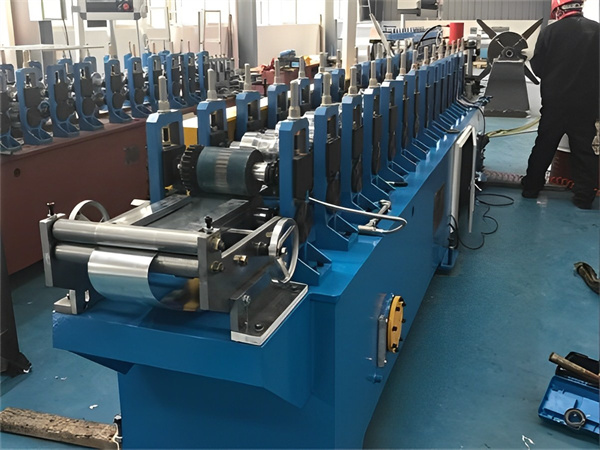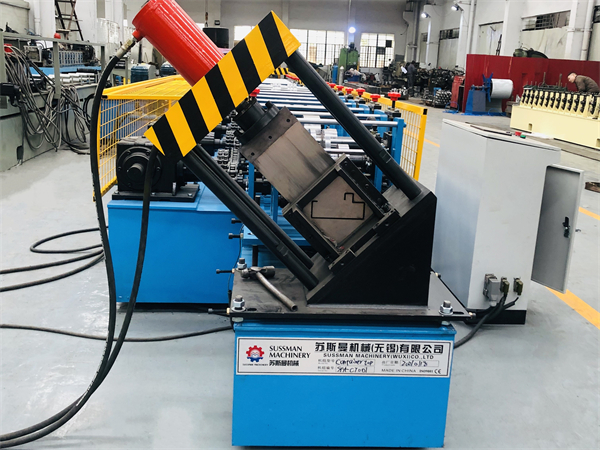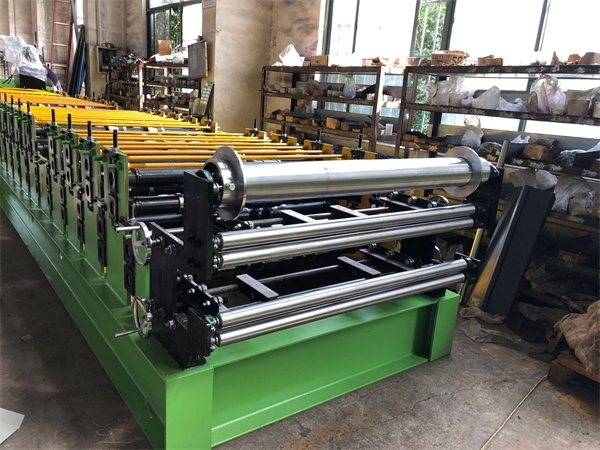Dans le monde de la construction moderne et de la fabrication industrielle, l'efficacité et la précision sont primordiales. La panne en C est l'un des éléments essentiels à la construction de structures solides. Les pannes en C font partie intégrante du soutien structurel des toits et des murs, ce qui les rend essentielles dans diverses industries. Pour répondre à la demande de ces composants vitaux, l'entreprise Machine de formage de rouleaux de panne C s'est imposée comme une merveille technologique. Découvrons le fonctionnement interne de ces machines et la manière dont elles contribuent au paysage de la construction.
Comprendre l'importance des pannes en C
Les pannes C, souvent appelées "poutres de pannes", sont des éléments structurels horizontaux qui jouent un rôle essentiel en supportant la charge des toits et des murs dans les projets de construction. Elles assurent la stabilité et la solidité de la charpente, garantissant ainsi la durabilité de la structure dans le temps. Les pannes en C sont largement utilisées dans les bâtiments commerciaux, industriels et résidentiels en raison de leur polyvalence et de leur efficacité dans les applications porteuses.

Fonctionnement des profileuses pour pannes en C
Les profileuses pour pannes en C sont des machines industrielles spécialisées conçues pour fabriquer des pannes en acier en forme de C, qui sont couramment utilisées dans l'industrie de la construction pour fournir un support structurel aux toits et aux murs. Ces machines utilisent un processus de profilage pour transformer des bandes plates de métal, généralement de l'acier, en un profil en forme de C.
Voici comment fonctionne une profileuse de pannes en C typique :
- Chargement du matériel: Le processus commence par le chargement d'une bobine de feuillard plat sur la dérouleuse de la machine. Le matériau de la bande est généralement de l'acier et son épaisseur peut varier en fonction des spécifications de conception.
- Redressement et alimentation: La bande de métal sort souvent de la bobine avec de légères courbures ou déformations. La bande passe par un ensemble de rouleaux qui la redressent et veillent à ce qu'elle soit introduite uniformément dans le processus de formage par laminage.
- Stations de formage de rouleaux: La machine se compose d'une série de stations de profilage, chacune d'entre elles étant équipée de paires de rouleaux. Ces rouleaux sont conçus pour façonner progressivement la bande plate dans le profil en forme de C souhaité. Chaque station effectue une opération spécifique de cintrage ou de façonnage, telle que le cintrage de la bride, l'enroulement de la lèvre et le façonnage de la bande. La bande passe par plusieurs stations en séquence, chaque station contribuant au profil final.
- Conception des rouleaux: Les rouleaux sont soigneusement conçus pour plier progressivement la bande de métal sans provoquer de contraintes excessives susceptibles d'endommager le matériau. Les dimensions du profilé sont déterminées par la conception des galets et l'espacement entre eux.
- Coupe et mesure de la longueur: Après avoir traversé toutes les stations de profilage, le profilé continu de la panne en forme de C est coupé à la longueur souhaitée. Cette coupe est souvent réalisée à l'aide d'un mécanisme de cisaille volante, qui assure des coupes précises et nettes. La machine intègre également des capteurs de mesure de la longueur pour garantir une coupe précise.
- Empilage ou emballage: Une fois que les sections de pannes individuelles sont coupées, elles sont généralement empilées ou emballées en vue d'un traitement ou d'un transport ultérieur.
- Système de contrôle: L'ensemble du processus est contrôlé par un système de commande informatisé. Ce système gère la vitesse de la machine, les réglages de la station de profilage, les opérations de coupe et les mesures de longueur. Il garantit que le produit final répond aux spécifications requises.
Les profileuses de pannes C sont conçues pour une efficacité et une précision élevées. Elles peuvent produire un grand nombre de pannes dans un laps de temps relativement court tout en conservant une qualité et une précision constantes. Ces machines jouent un rôle crucial dans l'industrie de la construction, en permettant la production de composants structurels essentiels pour divers projets de construction.
Avantages de l'utilisation de profileuses pour pannes en C
Efficacité et rapidité accrues
Les méthodes traditionnelles de fabrication des pannes en C impliquaient un travail manuel et prenaient beaucoup de temps. Les profileuses pour pannes en C ont révolutionné ce processus en automatisant la ligne de production, ce qui a permis d'accroître considérablement la vitesse et l'efficacité de la fabrication.
Précision et cohérence
Le caractère automatisé des profileuses garantit l'uniformité de la forme et de la taille de chaque panne en C produite. Cette uniformité est essentielle pour maintenir l'intégrité structurelle de la construction finale.
Économies de matériaux et de coûts
Les profileuses de pannes C optimisent l'utilisation des matériaux et minimisent les déchets. En outre, leurs capacités de production à grande vitesse contribuent à réduire les coûts de main-d'œuvre et à accélérer les délais d'achèvement des projets.

Composants clés d'une profileuse pour profilés en C
Pour comprendre les mécanismes des profileuses de pannes C, examinons leurs principaux composants :
Dérouleur
Le dérouleur est chargé de maintenir et d'alimenter la matière première (bobines d'acier) dans la machine. Il assure une alimentation continue en matériau pendant le processus de formage.
Système d'alimentation
Le système d'alimentation guide la bobine d'acier tout au long du processus de profilage, en veillant à ce qu'elle conserve un alignement et une tension corrects.
Unité de formage par laminage
Le cœur de la machine, l'unité de profilage, se compose d'une série de rouleaux qui façonnent progressivement l'acier pour obtenir le profil de panne en C souhaité.
Mécanisme de poinçonnage et de coupe
Ce mécanisme perfore les trous et coupe les pannes en C aux longueurs requises, créant ainsi les caractéristiques nécessaires à l'installation.
Système de contrôle PLC
L'automate programmable (PLC) supervise et coordonne l'ensemble du processus de fabrication, depuis l'alimentation en matière première jusqu'à la découpe des pannes en C finies.
Choisir la bonne profileuse pour pannes en C
Le choix de la profileuse pour pannes en C appropriée est crucial pour assurer une production sans faille. Tenez compte des facteurs suivants pour prendre votre décision :
Capacité de production
Évaluez la vitesse de production de la machine en fonction des exigences et des délais de votre projet.
Compatibilité matérielle
Assurez-vous que la machine peut traiter le type et l'épaisseur du matériau que vous avez l'intention d'utiliser pour vos pannes en C.
Options de personnalisation
Recherchez des machines qui offrent une certaine souplesse dans la production de pannes en C de tailles et de profils différents pour répondre aux besoins de projets variés.
Fonctionnalités d'automatisation
Les profileuses modernes sont dotées de fonctions d'automatisation avancées qui améliorent l'efficacité et réduisent la nécessité d'une intervention manuelle.

Installation et maintenance des profileuses pour profilés en C
Préparatifs avant l'installation
Avant l'installation, assurez-vous que l'espace de travail est correctement aménagé pour accueillir la machine et son fonctionnement.
Processus d'installation
L'installation par un professionnel est cruciale pour garantir les performances optimales et la longévité de la machine. Cette étape implique un alignement précis, un calibrage et des tests.
Étapes de l'entretien régulier
L'entretien de routine, tel que la lubrification, les contrôles d'alignement et les inspections des composants, est essentiel pour éviter les temps d'arrêt et prolonger la durée de vie de la machine.
Applications réelles du laminage de pannes en C
Les pannes en C trouvent des applications dans divers secteurs et industries :
Industrie de la construction
Les pannes en C sont largement utilisées dans la construction de bâtiments industriels, d'entrepôts et d'espaces commerciaux en raison de leur intégrité structurelle et de leur rentabilité.
Installations d'entreposage et de stockage
La conception polyvalente des pannes en C les rend idéales pour créer des structures solides dans les installations de stockage et les entrepôts.
Structures agricoles
Les pannes en C fournissent le support nécessaire aux structures agricoles telles que les granges et les hangars, protégeant ainsi le bétail et l'équipement.
Tendances futures de la technologie de formage de rouleaux de pannes en C
La technologie continue d'évoluer, tout comme les machines de profilage de pannes C :
Amélioration de l'automatisation et de l'intégration
Les progrès de l'automatisation conduiront à des processus de production encore plus rationalisés et intégrés.
Compatibilité améliorée des matériaux
Les futures machines pourront traiter une gamme encore plus large de matériaux, ce qui élargira leurs applications.
Efficacité énergétique
Les efforts visant à réduire la consommation d'énergie dans la fabrication pourraient déboucher sur des machines plus respectueuses de l'environnement.

Conclusion
Les profileuses pour pannes en C ont révolutionné le secteur de la construction en offrant des solutions efficaces, précises et rentables pour la production de composants structurels essentiels. Grâce à leurs fonctions d'automatisation et à leur adaptabilité, ces machines sont appelées à façonner l'avenir de la construction, en permettant la création de bâtiments plus solides et plus durables.
FAQ
- Quel est le rôle des pannes C dans la construction ? Les pannes en C assurent le soutien structurel des toits et des murs dans divers projets de construction.
- Comment les profileuses pour pannes en C améliorent-elles l'efficacité ? Ces machines automatisent le processus de production, augmentant la vitesse, la précision et les économies de matériaux.
- Quels sont les facteurs à prendre en compte lors du choix d'une profileuse ? Évaluer la capacité de production, la compatibilité des matériaux, les options de personnalisation et les fonctions d'automatisation.
- Où les pannes en C sont-elles couramment utilisées ? Les pannes en C trouvent des applications dans les secteurs de la construction, de l'entreposage et de l'agriculture.
- Quel est l'avenir de la technologie de profilage des pannes en C ? Les tendances futures comprennent l'amélioration de l'automatisation, de la compatibilité des matériaux et de l'efficacité énergétique.
